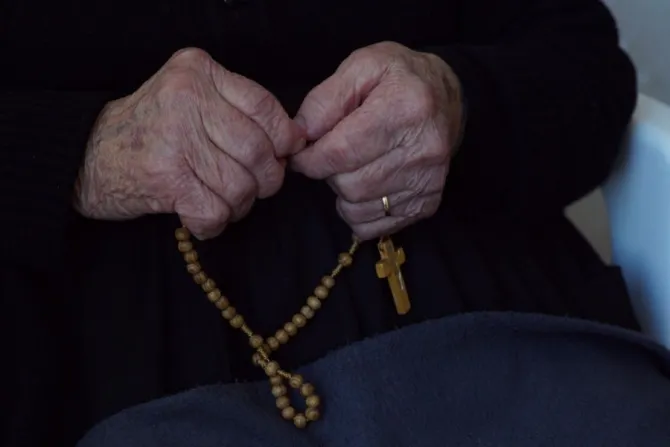The niece of Lucia Santos, Maria Dos Anjos Rua, praying the rosary at the Shrine of Our Lady of Fatima in Fatima, Portugal on April 6, 2017./ Daniel Ibanez/CNA
October is designated by the Catholic Church as the “Month of the Rosary” because today the Church celebrates the Marian advocation of “Our Lady of the Rosary”.
The feast of Our Lady of the Rosary, also celebrated as Our Lady of Victory or Victories, was established by Pope St. Pius V in 1571 to celebrate the miraculous victory of the Christian forces in the Battle of Lepanto on Oct. 7 of that year. Previous to the decisive battle, St. Pius V had requested all Western Christians to pray the rosary; thus he attributed the victory to the power of the Marian prayer rather than the power of ships and cannons.
Two years before establishing the feast, in 1569, Pope St. Pius V officially approved the rosary in its present form with the papal bull Consueverunt Romani Pontifices (“The Roman Pontiffs are accustomed,” the first words of the document). In a development from earlier methods of praying the rosary, the new version included the second half of the Hail Mary, as well as the “Glory Be” prayer at the end of each mystery.
In Consueverunt Romani Pontifices, St. Pius V established the two essential elements of the rosary: vocal prayer and mental prayer. This fact has been highlighted by all Marian saints, especially Louis-Marie Grignion de Montfort (1673 – 1716), author of popular Marian books such as “The Admirable secret of the Rosary,” “True Devotion to the Blessed Virgin,” and “Methods for Saying the Rosary.”
The dedication of the month of October to the Holy Rosary became common in the Church thanks to Pope Leo XIII, an enthusiastic promoter of the rosary. In the span of only five years, Pope Leo wrote eleven encyclicals on the rosary.
St. John Paul II called the rosary his favorite prayer, “in which we meditate with Mary upon the mysteries which she as a Mother meditated on in her heart (Lk. 2:19.).”
Source: CNA

